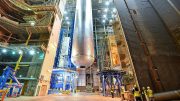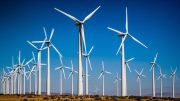H2Perth is intended as one of the largest global facilities for export of ammonia and liquid hydrogen
Woodside has unveiled plans to establish a world-class hydrogen and ammonia production facility in Perth, Western Australia.
H2Perth, intended to make Western Australia a “hydrogen powerhouse”, would be built on 130 hectares of vacant industrial land to be leased from the government in the Kwinana Strategic Industrial Area and Rockingham Industry Zone.
The first phase of the facility, dubbed H2Perth, will involve more than A$1 billion (US$749 million) in capital expenditure.
Construction is expected to create more than 2000 jobs. Once operational, it is estimated the facility will support more than 200 ongoing local jobs.
H2Perth is a phased development that, at full potential, would be one of the largest facilities of its kind in the world, producing up to 1500 tonnes per day of hydrogen for export in the form of ammonia and liquid hydrogen.
In addition to meeting a shared goal of hydrogen export in the second half of the decade, Woodside aims to support state initiatives to stimulate local hydrogen demand, particularly in transport and heavy industry.
Local refuelling stations can be built independently of the export project timelines and could operate as early as 2023, subject to approvals and customer demand.
Hydrogen and ammonia from H2Perth would be produced using both electrolysis technologies and natural gas reforming, with 100% of carbon emissions abated or offset, according to Woodside.
The electrolysis component of production will have an initial capacity of 250 megawatts, with potential to scale to more than 3 gigawatts in line with customer demand and renewable energy growth.
The initial phase of the steam methane reformer will consume 40 terajoules per day of natural gas. Initially, H2Perth will target 300 terajoules per day of hydrogen production, or 20% of expected total capacity, which can be converted into 600,000 tonnes per annum (tpa) of ammonia or 110,000 tpa of liquid hydrogen.
The company will now begin community engagement on H2Perth. Subject to commercial and regulatory approvals, and the final investment decision, construction is estimated to start in 2024 and production start-up in 2027.
The initial stage of H2Perth will produce 300 tonnes per day of hydrogen, of which 200 tpd will be from methane reforming and 100 tpd from electrolysis.
H2Perth will be a net-zero project. Woodside will use a combination of abatements, offsets and renewable energy certificates to offset 100% of all emissions. For offsets, bio-sequestration is the company’s base case but it is also actively pursuing opportunities for carbon utilisation, whereby the emitted carbon is turned into useful products.
Upstream understands Woodside will look at enabling more renewables to enter the grid as future phases require more power.
“It is fantastic to see a major Western Australian company like Woodside investing in hydrogen here in WA,” said the nation’s Hydrogen Industry Minister Alannah MacTiernan.
“The scale of this project will help secure the local manufacture of critical components, and will underpin an expansion of renewable energy on the South West Interconnected System.
“We have more than 30 hydrogen project proposals on the table here in Western Australia, and we are proud to have worked with Woodside to deliver one of the world’s first major clean hydrogen production facilities in WA,” she said.
Woodside chief executive Meg O’Neill said H2Perth would be a landmark for both the company and the state.
“Woodside has a proud track record as an Australian oil and gas producer, and our liquefied natural gas exports will continue helping Asia to reliably meet its energy needs while reducing greenhouse gas emissions for decades to come,” she said.
“Now, we intend to use our skills and financial strength to add new energy products and lower-carbon technologies and services to our portfolio, which can be scaled to meet customer demand.
“The land being leased… in the Kwinana and Rockingham areas is ideally located close to existing gas, power, water and port infrastructure, as well as a skilled local residential workforce. These advantages will make a huge difference to cost of supply and schedule and help H2Perth deliver competitively priced hydrogen to customers.”
O’Neill said H2Perth would facilitate the substantial growth of renewables in Western Australia by providing to the grid a flexible and stabilising load that benefits uptake of intermittent renewable electricity by households and industry.
“H2Perth is designed to be net-zero emissions for both Woodside and its customers, supporting Woodside’s corporate emissions reduction targets and the Paris Agreement goals of customers in the region,” she said.
“We look forward to H2Perth establishing Western Australia as a global hydrogen leader, building on our state’s existing resources and capabilities and helping lead us into a lower-carbon future — something everyone can be proud of.”
H2Perth is eventually expected to operate electrolysers with a total capacity of more than 3 GW. The current registered generation capacity of Western Australia’s entire South West Interconnected System is 5.8 GW.
Kwinana is a vital node in the Western Australian electricity network, Woodside said.
“The hydrogen electrolysers can help stabilise this network because they can be operated flexibly (by being switched on and off quickly),” it added.
“This can help the network support more intermittent renewable power, such as residential rooftop PV and large-scale renewable generation, as the state transitions to greener electricity.”
In the 2021-2022 State Budget, the Western Australian government of Premier Mark McGowan committed an additional A$61.5 million to boost the state’s renewable hydrogen industry.





